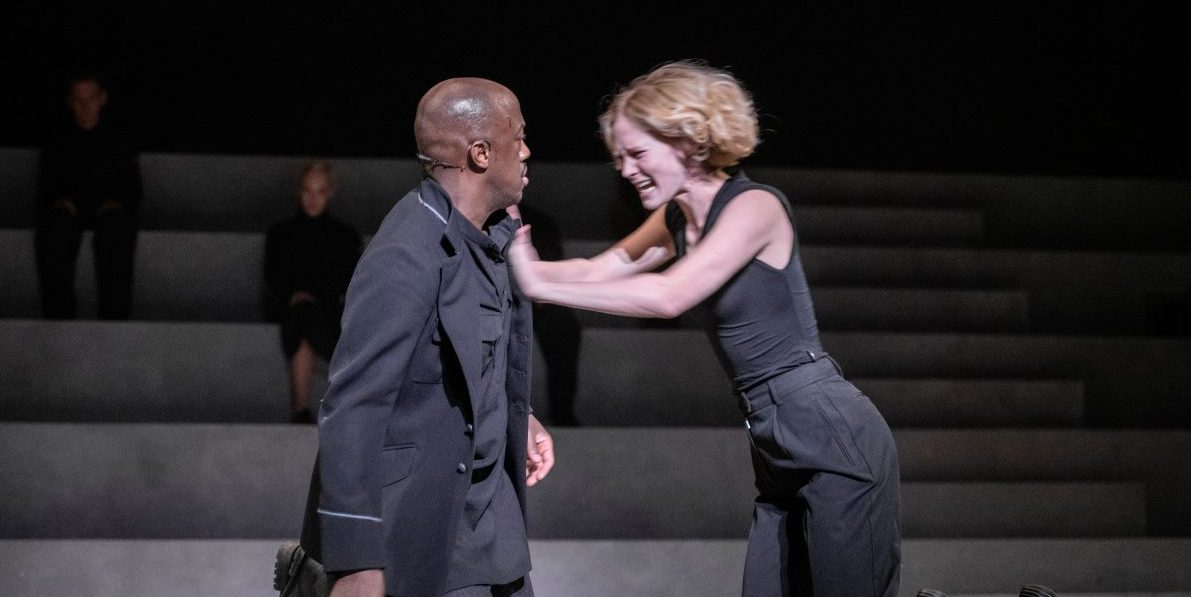I still remember going to the National to watch Nicholas Hytner’s production of Othello for the Olivier stage. Almost ten years have passed since that visit, and strangely enough (despite numerous other visits to staging of Shakespeare’s classics) I hadn’t got to watch another revival of Othello.
This made me look forward to my visit to the Lyttelton last week and to Clint Dyer’s new production of Shakespeare’s famous tragedy.
There is something quite exciting in the experience of watching a classic: you know what will happen in the end, you know that nothing will shock or surprise you in terms of the main events, so what is exhilarating is anticipating not the ‘what’ but the ‘how’. How will this time Othello end up trapped in his labyrinth of jealousy? How will this time Iago ‘poison’ Othello’s mind? How will this time Desdemona respond to her husband’s sudden change of character?
Paul Hilton’s Iago was tremendous: sly and cunning, and always so mischievous. It has always struck me how the play is so much dependent on Iago – he is something more than a mere antagonist and the main reason why the drama in the play exists. Hilton certainly stood up to the challenges of his part, embracing the villainous nature of Iago. It is very interesting exploring the motives behind Iago’s deceit. Is it pure malice? Or perhaps racism? Or even jealousy itself.
Even though I felt the relationship between Iago and Othello (is it friendship?) could have been further explored in the production, Giles Terera is a very powerful Othello. At the start of the production, he appears so calm and steady, unshakeable almost. His descent to utter rage came perhaps a bit too sudden and quick – but truly his transformation was fierce! No matter how many times I read/watch the play, it always strikes me as utterly devastating how jealousy has the power to plague Othello and leads him to the most abominable crime. Desdemona is yet another silent victim. Indeed, the double femicide is a truly tragic ending, leaving the audience with no choice but to detest the two male characters and their possessive stance towards their wives. Emilia’s visible bruises were powerful reminders that she too is a victim of domestic abuse, and her choice to call out her husband’s actions, meant – as indeed proven by her murder – real danger. Dyer’s production, unlike perhaps other productions of Othello that I have watched, tried to give real agency to the two female characters. Particularly Rosy McEwen’s Desdemona came across as a confident and intelligent young woman.
Chloe Lamford’s set design solves the common problem of the Lyttelton stage by creating an arena with steps on three sides, and thus reducing the performance space’s width. The concrete space added to the coldness of the atmosphere and transported the action in a more symbolic and timeless space.
Perhaps what was Dyer’s most interesting directorial idea was the use of a chorus (called “The System” in the programme) in which all actors – except for Terera, McEwen, and Hilton – take part. Through stylised movement (with movement direction by Lucie Pankhurst) the chorus is present in key moments and provides a very interesting insight into the main characters’ thoughts and psyche. The chorus was particularly exciting in soliloquies, providing not only an actual audience for the characters’ inner thoughts, but also a distortive mirror of their twisted minds, particularly for Othello and Iago.
The excellent lighting design (by Jai Morjaria), as well as the detailed sound design and menacing composition (by Pete Malkin and Bejamin Grant) were tremendous in creating an arresting atmosphere, punctuating key moments. Indeed, the use of lighting and sound gave the whole production a very fresh and modern feel. I was not totally convinced of the function of the video projections, but I did appreciate the use of video design as a close collaborator of lighting design. All in all, Dyer realises a very solid production.

